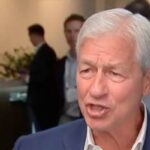Tracy and Dale McMullen are Canadians who had a vacation home in Buckeye, Arizona, for five years until they sold it in April. The couple typically spent four to five months a year in the U.S., but now say they don’t plan on returning anytime soon.
“We decided to sell the property after the current POTUS took office,” Dale told Reuters, referencing President Donald Trump, in a story published on April 22. “We felt we could not trust what he might do next to us as individuals and to our country. We no longer felt welcome nor safe.”
Don’t miss
- I’m 49 years old and have nothing saved for retirement — what should I do? Don’t panic. Here are 5 of the easiest ways you can catch up (and fast)
- Thanks to Jeff Bezos, you can now become a landlord for as little as $100 — and no, you don’t have to deal with tenants or fix freezers. Here’s how
- Gain potential quarterly income through this $1B private real estate fund — even if you’re not a millionaire. Here’s how to get started with as little as $10
Tracy and Dale are among a number of Canadian snowbirds re-thinking their annual vacation plans to escape the wintery cold up north in favor of sunny U.S. destinations.
So, why exactly are Canadians deciding to pack up and stay home, and what impact could this have on local U.S. economies?
How much do Canadians spend on real estate in the U.S.?
According to National Association of Realtors (NAR) data, Canadians spent a total of around $5.9 billion in U.S. residential real estate between April 2023 and March 2024, making up 13% of foreign purchases.
These buyers bought homes at an average of a $834,000 price tag, making it the second highest average amount. This was credited to Canadian buyers purchasing homes in resort areas, where property tends to be more expensive.
Florida (41%) and Arizona (23%) topped the list of states where Canadians purchase homes, making up almost two-thirds of home sales. Nearly half (49%) of Canadians bought these properties as vacation homes, while one-fifth (22%) intended to use them for both vacations and renting.
But this year could tell a different story, say those in the industry. Andrea Hartmann, managing partner of the Sandy Hartmann Group, says peak buying season for condos in the Tampa Bay area is in the first quarter of the year.
“We have not received an offer [this year] from a Canadian buyer even once, and normally we would,” she told Reuters.
Read more: Want an extra $1,300,000 when you retire? Dave Ramsey says this 7-step plan ‘works every single time’ to kill debt, get rich in America — and that ‘anyone’ can do it
Why are Canadian homeowners selling their U.S. homes?
Trump threatened to impose widespread tariffs on goods from Canada as early as February. Although the president has delayed many of these levies, a number were still put in place. Meanwhile, Canada implemented retaliatory tariffs of its own on select U.S. products.
In addition, repeated comments by the president suggesting Canada become America’s 51st state — going so far as to mockingly refer to former Prime Minister Justin Trudeau as “governor” — were perceived by many Canadians as a threat to the country’s sovereignty.
But there may be reasons beyond political friction Canadians may want to put up “For Sale” signs on their vacation home lawns in the U.S.
Four major hurricanes have ripped through Florida in the last several years, and these natural disasters have had an impact on home insurance premiums. Several companies have pulled out of the state, while others have increased prices. As of May 1, the average cost of insurance for a $300,000 home in the state is $5,292 per year — more than twice the national average of $2,329 per year — according to data from Bankrate.
“Now with the political issue, the cost of maintaining a place here in Florida and the insurance, a lot of them decided to sell and go,” Ken O’Brian, owner of Southwest Coast Realty in Naples, which specializes in helping Canadians purchase real estate, told Reuters.
In Arizona, realtor Laurie Lavine told Reuters he’s seen more listings from Canadians wanting to sell homes this year. Usually, there are around two to four listings per quarter, but at the time of publication he said there were 18 active listings. He added that Canadians are feeling “picked on” by U.S. border agents enforcing stricter rules.
“There is no incentive to come to the States anymore,” Donny B. of Ontario, who is trying to sell two investment properties in Florida, told Reuters. He declined to give his surname, the publication says, because he feared backlash. “I’m like, ‘are people going to be pissed off at me?’”
How this could impact local economies
The shift in real estate purchase decisions from Canadians could indirectly affect how homes will be bought and sold.
If there are more listings, it could mean that buyers in these areas have more inventory to choose from and less competition from others putting offers on the same homes. For realtors, the lower number of buyers could be offset by more opportunities to help sellers list their homes.
However, less Canadians — even tourists and not homeowners — could spell less incomes for local businesses. Time will tell how snowbirds flocking away from the country will have an impact on the U.S.
What to read next
- Don’t have the cash to pay Uncle Sam in 2025? You may already be eligible for a ‘streamlined’ handshake with the IRS — here’s how it works and how it can potentially save you thousands
- Here are 5 ‘must have’ items that Americans (almost) always overpay for — and very quickly regret. How many are hurting you?
- Robert Kiyosaki warns of a ‘Greater Depression’ coming to the US — with millions of Americans going poor. But he says these 2 ‘easy-money’ assets will bring in great wealth. How to get in now
This article provides information only and should not be construed as advice. It is provided without warranty of any kind.







